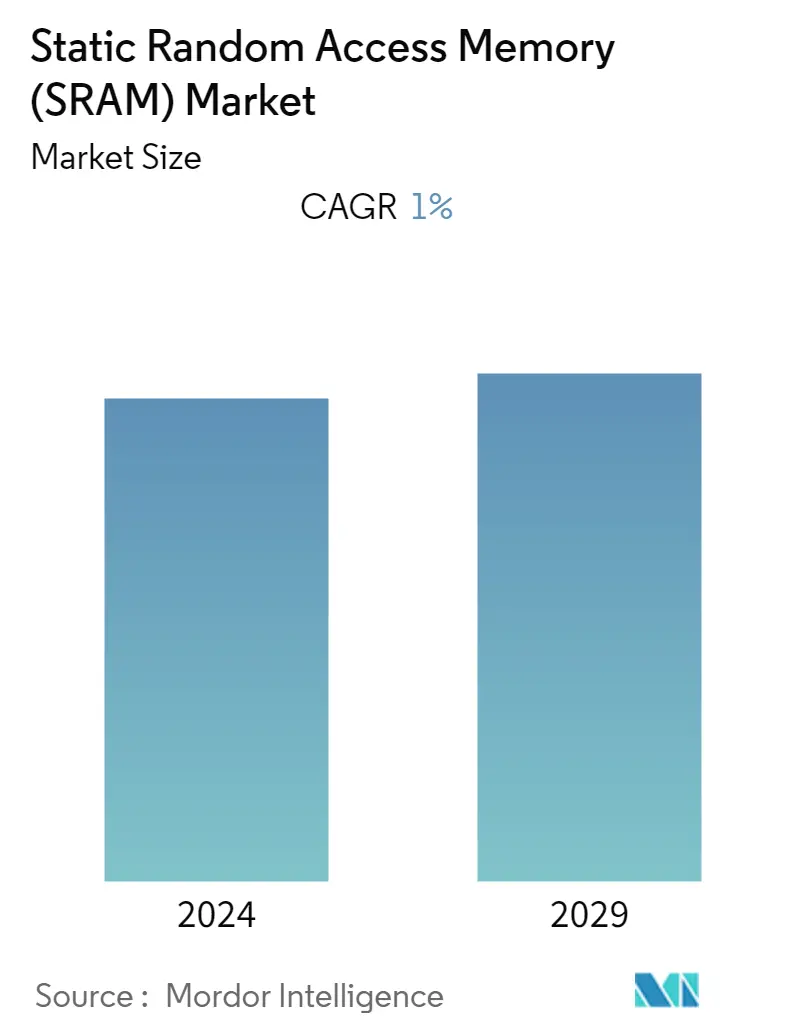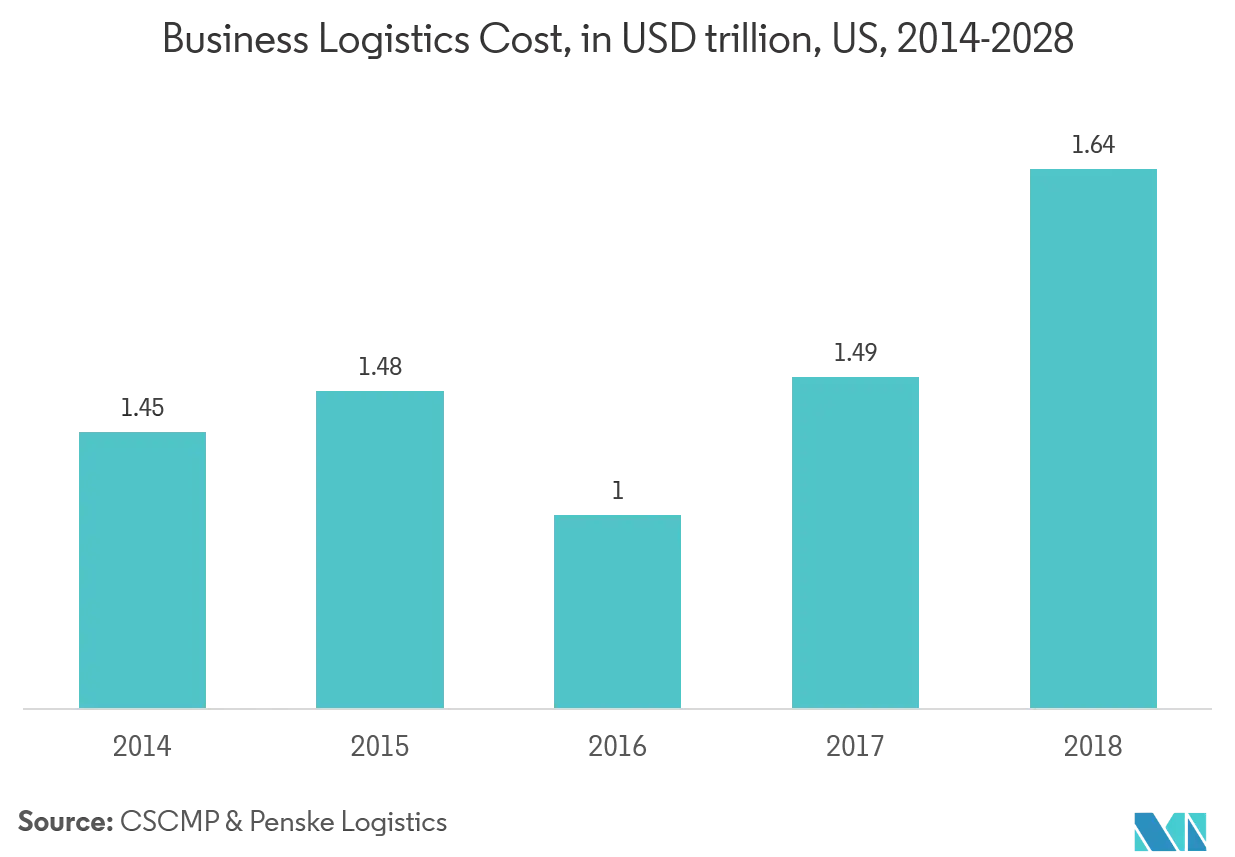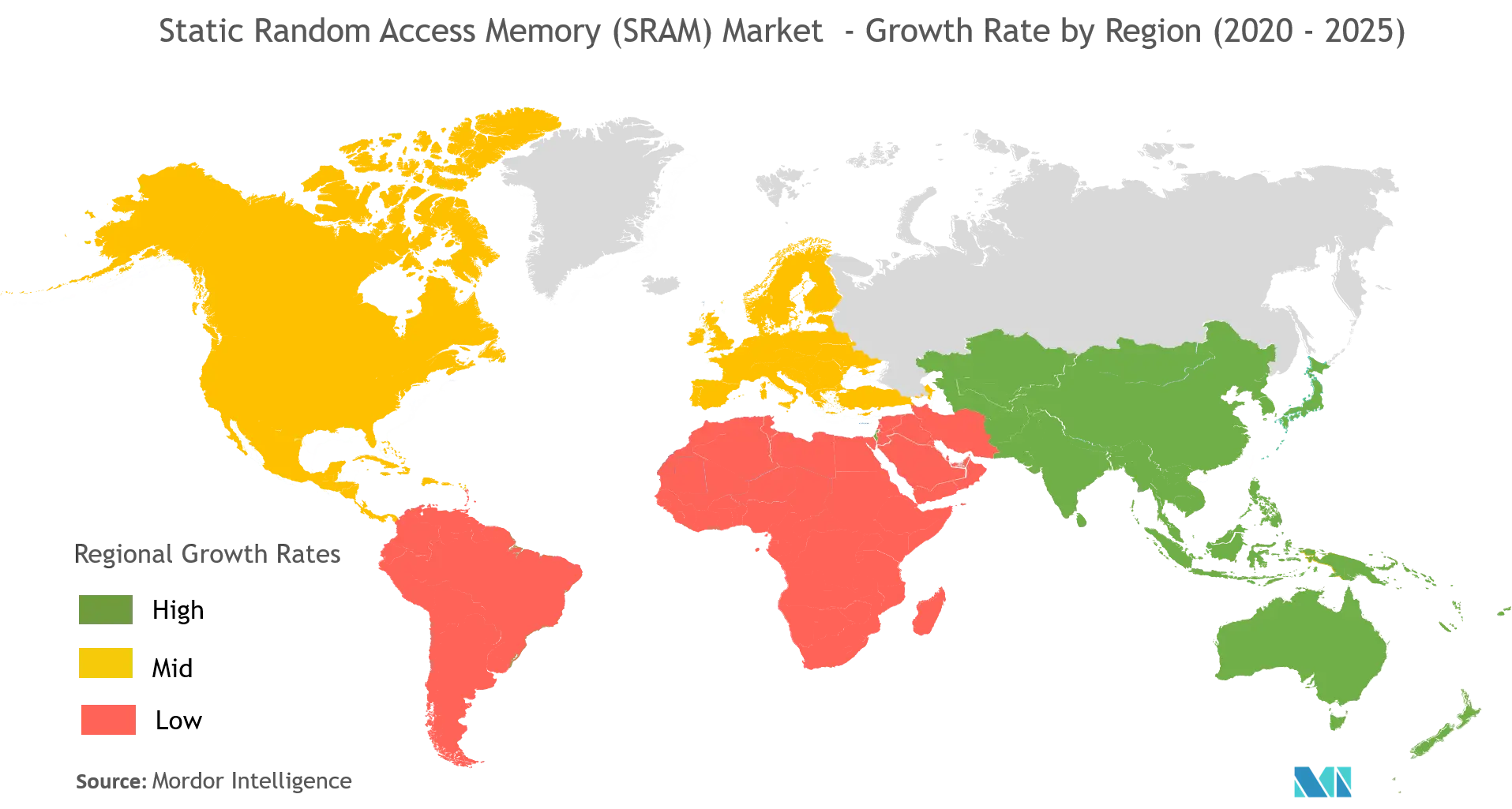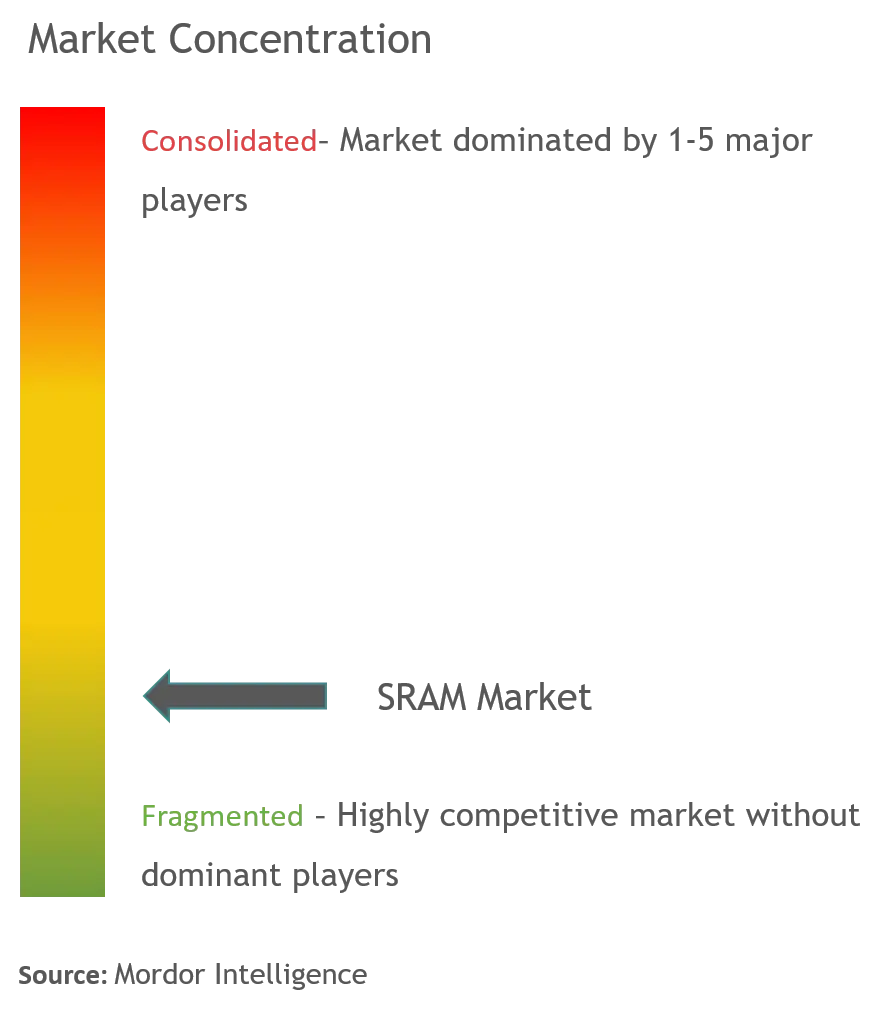Static Random Access Memory Market Size

| Study Period | 2019 - 2029 |
| Base Year For Estimation | 2023 |
| CAGR | 1.00 % |
| Fastest Growing Market | Asia Pacific |
| Largest Market | Asia Pacific |
| Market Concentration | Low |
Major Players
*Disclaimer: Major Players sorted in no particular order |
Static Random Access Memory Market Analysis
The static random access memory market has registered a CAGR of -1.96% over the forecast period 2021 - 2026.
- The demand for electronics components in the consumer electronics segment and microcontrollers, embedded systems, programmable devices and application-specific ICs in the industrial and scientific sector, automotive industry, aerospace industry, and life sciences industry has experienced a continued overall escalation.
- The growth of this industry, coupled with technological advancements and improved infrastructure has directly impacted the demand for multiple components that are used as the building blocks of such systems. SRAM has been one similar segment impacted by the growth in the electronics industry.
- In the first role, the SRAM serves as cache memory, interfacing between DRAMs and the CPU. Currently, a majority of the SRAM manufacturers have stopped at Level 3 cache. AMD filed for a patent for using (High Bandwidth Memory) HBM as an L4 cache. The idea of use is still debated by the industry experts as L4 cache on a chip has not been presented yet.
- According to industry experts, SRAM has continued to remain a necessity in the market. The qualities in the Fin Field Effect Transistors (FinFET) have remained good even for 10 nm and below chips. Vendors are investing significantly by improving the density efficiency and offer a device with reduced power consumption.
Static Random Access Memory Market Trends
This section covers the major market trends shaping the Static Random Access Memory Market according to our research experts:
Consumer Electronics to Hold Significant Share
- The demand for cellular RAM is growing at a rapid rate and increasing the application of SRAM in cellular devices is expected to impact the market. Flash memory can be replaced by SRAMs, thus, providing several opportunities for the manufacturers. The increase in sales of smartphones is expected to increase the demand for mobile SRAMs, making smartphones the major revenue-generating source in the global mobile SRAM market.
- The requirements for high-speed performance are continuously increasing in consumer electronics owing to the rising need for memory density and high processing power while maintaining the cost of the product more or less intact.
- Equipped with advanced technologies such as IoT, AI, and big data analytics, the SRAM has the capability to address the requirements pertaining to processing speeds and memory density in the consumer electronics sector. It is coupled with the advanced technologies, can be used to store the vast amounts of data that is being generated in the industry.
- Cisco Systems estimates that the number of connected wearable devices worldwide could reach 1,105 million units by 2022 from 593 million units in 2018. This growth of IoT and wearable technology would provide adoption opportunities for the market studied.

Asia-Pacific to Hold Major Share
- Asia-Pacific is anticipated to hold major share over the forecast period, mainly with the growing demand from China, Japan, and South Korea, owing to the presence of key industry participants. The rising popularity of smartphones and demand for newer memory technologies have increased the growth of computationally-intensive consumer electronics, thereby, creating a range of opportunities for SRAM in this region.
- For embedded high-speed applications, Static Random Access Memory (SRAM) continues to be the memory of choice, from mobile to high-performance servers being utilized in Asia-Pacific.
- System-on-chip (SoC) is one of the most modern forms of technology being underutilized and further research for high-speed applications is ongoing. This technology has nominated a large number of different research areas which would lead the existing technology towards one of the most widely used computing technology.
- Indian companies are positioning themselves to benefit from the shift to mobile devices, multimedia, networking and broadband applications, all of which are bolstering the demand for SoC technology. According to the International Technology Roadmap for Semiconductors (ITRS), embedded SRAM will continue to dominate the area of SoCs approaching 90% within 2020.

Static Random Access Memory Industry Overview
The static random access memory market is highly fragmented as themarket is highly competitive and consists of several major players. The competitive rivalry in this industry is primarily dependent on the sustainable competitive advantage through innovation, levels of market penetration, and power of competitive strategy. SRAM vendors are investing significantly to develop more efficient forms of SRAM technologies. For instance, OEM manufacturers are integrating more compact forms of technologies in their product offerings and are demanding compact SRAM modules for their respective product offerings.
- April 2019 -Cypress Semiconductor Corp.announced that it has closed its joint venture transaction with SK Hynix system ic, Inc., which wasannounced on October 25, 2018. Allregulatory approvals have been completedand the joint venture, SkyHigh Memory Limited, has now begun full operations.
Static Random Access Memory Market Leaders
-
Renesas Electronics Corporation
-
STMicroelectronics N.V.
-
Toshiba Corporation
-
Cypress Semiconductor
-
Integrated Silicon Solution, Inc. (ISSI)
*Disclaimer: Major Players sorted in no particular order

Static Random Access Memory Market Report - Table of Contents
1. INTRODUCTION
- 1.1 Study Deliverables
- 1.2 Study Assumptions
- 1.3 Scope of the Study
2. RESEARCH METHODOLOGY
3. EXECUTIVE SUMMARY
4. MARKET DYNAMICS
- 4.1 Market Overview
- 4.2 Introduction to Market Drivers and Restraints
-
4.3 Market Drivers
- 4.3.1 Emerging High-performance Network Applications
- 4.3.2 Increasing Demand for Faster Cache Memories
-
4.4 Market Restraints
- 4.4.1 Comparatively High Costs and Power Consumption in Specific Use Cases
- 4.5 Industry Value Chain Analysis
-
4.6 Industry Attractiveness - Porter's Five Forces Analysis
- 4.6.1 Threat of New Entrants
- 4.6.2 Bargaining Power of Buyers/Consumers
- 4.6.3 Bargaining Power of Suppliers
- 4.6.4 Threat of Substitute Products
- 4.6.5 Intensity of Competitive Rivalry
- 4.7 Assessment of Impact of Covid-19 on the Industry
5. MARKET SEGMENTATION
-
5.1 Function
- 5.1.1 Asynchronous SRAM
- 5.1.2 Synchronous SRAM
-
5.2 Product Type
- 5.2.1 Pseudo SRAM (PSRAM)
- 5.2.2 Non Volatile SRAM (nvSRAM)
- 5.2.3 Other Product Types
-
5.3 End User
- 5.3.1 Consumer Electronics
- 5.3.2 Industrial
- 5.3.3 Communication Sector
- 5.3.4 Other End Users
-
5.4 Geography
- 5.4.1 North America
- 5.4.2 Europe
- 5.4.3 Asia Pacific
- 5.4.4 Latin America
- 5.4.5 Middle-East and Africa
6. COMPETITIVE LANDSCAPE
-
6.1 Company Profiles
- 6.1.1 Cypress Semiconductor Corporation
- 6.1.2 Integrated Silicon Solution Inc. (ISSI)
- 6.1.3 GSI Technology Inc.
- 6.1.4 Integrated Device Technology Inc.
- 6.1.5 Samsung Electronics Co. Ltd
- 6.1.6 Toshiba Corporation
- 6.1.7 STMicroelectronics NV
- 6.1.8 Renesas Electronics Corporation
- *List Not Exhaustive
7. INVESTMENT ANALYSIS
8. MARKET OPPORTUNITIES AND FUTURE TRENDS
** Subject To AvailablityStatic Random Access Memory Industry Segmentation
SRAM (static RAM) is random access memory (RAM) that retains data bits in its memory as long as power is being supplied. Unlike dynamic RAM (DRAM), which stores bits in cells consisting of a capacitor and a transistor, SRAM does not have to be periodically refreshed. Static RAM provides faster access to data and is more expensive than DRAM.
| Function | Asynchronous SRAM |
| Synchronous SRAM | |
| Product Type | Pseudo SRAM (PSRAM) |
| Non Volatile SRAM (nvSRAM) | |
| Other Product Types | |
| End User | Consumer Electronics |
| Industrial | |
| Communication Sector | |
| Other End Users | |
| Geography | North America |
| Europe | |
| Asia Pacific | |
| Latin America | |
| Middle-East and Africa |
Static Random Access Memory Market Research FAQs
What is the current Static Random Access Memory (SRAM) Market size?
The Static Random Access Memory (SRAM) Market is projected to register a CAGR of 1% during the forecast period (2024-2029)
Who are the key players in Static Random Access Memory (SRAM) Market?
Renesas Electronics Corporation, STMicroelectronics N.V., Toshiba Corporation, Cypress Semiconductor and Integrated Silicon Solution, Inc. (ISSI) are the major companies operating in the Static Random Access Memory (SRAM) Market.
Which is the fastest growing region in Static Random Access Memory (SRAM) Market?
Asia Pacific is estimated to grow at the highest CAGR over the forecast period (2024-2029).
Which region has the biggest share in Static Random Access Memory (SRAM) Market?
In 2024, the Asia Pacific accounts for the largest market share in Static Random Access Memory (SRAM) Market.
What years does this Static Random Access Memory (SRAM) Market cover?
The report covers the Static Random Access Memory (SRAM) Market historical market size for years: 2019, 2020, 2021, 2022 and 2023. The report also forecasts the Static Random Access Memory (SRAM) Market size for years: 2024, 2025, 2026, 2027, 2028 and 2029.
Static Random Access Memory Industry Report
Statistics for the 2024 Static Random Access Memory market share, size and revenue growth rate, created by Mordor Intelligence™ Industry Reports. Static Random Access Memory analysis includes a market forecast outlook to 2029 and historical overview. Get a sample of this industry analysis as a free report PDF download.



